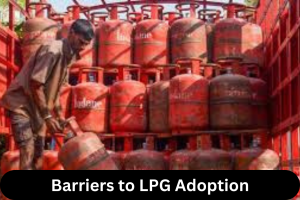ForumIAS announcing GS Foundation Program for UPSC CSE 2025-26 from 27th May. Click Here for more information.

Source – This post on Barriers to LPG Adoption has been created based on the article “The socio-ecological effects of LPG price hikes” published in “The Hindu” on 8 May 2024.
UPSC Syllabus- GS Paper 2 – Welfare Schemes for Vulnerable Sections of the population by the Centre and States and the Performance of these Schemes
Context-The article highlights the findings of the 2014-2015 ACCESS survey (conducted by the Council on Energy, Environment and Water) which states that the high cost of LPG is the foremost barrier to its adoption and continued use in rural poor households. Barriers to LPG Adoption
Around 750 million Indians use solid cooking fuels like wood, dung, agricultural residues, coal, and charcoal every day.
What are the negative impacts of using solid cooking fuels?
1) The use of solid cooking fuels is associated with numerous health hazards, socio-economic, and environmental impacts.
2) It degrades forests and exposes people to risks from wild animals.
What were some of the government initiatives to promote the use of LPG?
1) The Rajiv Gandhi Gramin LPG Vitrak scheme started in 2009 aimed to expand LPG distribution in remote regions. This has resulted in about 45 million new LPG connections from 2010 to 2013.
2) Direct benefit transfers for LPG under the ‘PAHAL’ scheme were initiated in 2015.
3) In 2016, home-delivery of LPG refills was introduced, and about 10 million LPG users voluntarily gave up subsidies, transferring them to households below the poverty line through the ‘Give it Up’ program.
4) Then came the Pradhan Mantri Ujjwala Yojana (PMUY), aiming to provide LPG connections to 80 million households below the poverty line by 2020. The scheme offers a subsidy of ₹200 for each 14.2-kg cylinder, raised to ₹300 in October 2023.
Read more- PM launches Ujjwala 2.0 Scheme
What are challenges in adoption and continued usage of LPG in India?
1) India had the most expensive LPG prices (about ₹300 per liter) compared to 54 other countries surveyed.
2) Poor people are not able to refill cylinders because of the high prices, even though they initially benefited from switching from fuelwood.
What are some of the suitable alternatives to fuelwood?
1) Planting high-fuelwood value native tree species in collaboration with local communities and forest departments.
2) Introducing efficient cooking stoves and optimizing shade tree density in tea plantations.
3) Multi-stakeholder meetings for resource governance.
What should be the way forward?
1) Future governments must focus on making and keeping LPG affordable.
2) There is a need to protect society and the environment from the negative effects of using solid cooking fuels. One potential solution is to implement a national policy that encourages the use of smokeless cooking stoves, which require less fuelwood.
Question for practice
Highlight the negative impacts of using solid cooking fuels? Despite these negative impacts? Why is its usage not reducing significantly?



